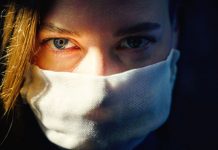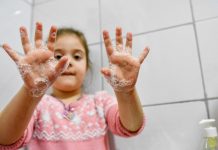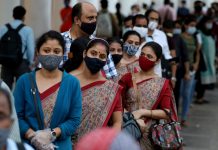No apparent change for the near future:
Dr. Timothy Brewer, a professor of medicine in the division of infectious diseases at the David Geffen School of Medicine at UCLA and a professor of epidemiology at the UCLA Fielding School of Public Health, said “it’s important for us all to recognize that due to lags in vaccine production and high demand, there’ll be no “immediate change” in our society”.
Daily life turns completely upside down over the course of the pandemic. It won’t be transitioning back to our pre-conceived idea of “normal” anytime soon.
But in his state of California, for instance, there aren’t enough vaccine doses to meet those in need. He said there are about 2.4 million Californians who fall in that highest priority category and, right now, there’s about one-sixth the amount of doses needed.
“Given how long it will take to address those most in need, we will see no noticeable change for the near future, just because there isn’t enough vaccine to have any meaningful impact immediately,” he said.
Dr. Dan Culver, a pulmonologist at Cleveland Clinic, said that it’s “unpredictable” to know exactly how this will all play out. But he echoed Brewer in that it would take a long time for the vaccine to effectively change the course of the pandemic domestically in the United States. He told that it will most likely be “well into the second quarter” of 2021 “before we can expect substantial changes.”
Beyond Brewer’s points about getting as many vaccine doses distributed to as many people as possible, Culver said we also have to take into account the strain our nation’s healthcare system is under right now.
What happens this month in terms of controlling virus transmission “will have ramifications on the healthcare system into February,” he said.
Given the current numbers are continuing to escalate, we should brace for high infection rates coinciding with a gradual release of the vaccine. Brewer said that each state is going to have to develop its own vaccine distribution plan and determine how and when it will be allocated.
He explained that given the Pfizer-BioNTech vaccine requires “ultracold storage” at 70°C you need facilities with minus -80°C freezers. One challenge is not all healthcare facilities in the country have this specific kind of storage.
This means that you’ll need facilities with the capacity to store vast quantities of the vaccine appropriately, and then disseminate it to other areas of a given state.
As with most other inoculations, the COVID-19 vaccine will require two doses, separated by about 3 to 4 weeks. Brewer and Culver said this is standard for most other kinds of vaccines.
Culver said that for this to be done well, there will have to be stringent public health tracking to make sure people know when, how, and where to get their second doses of the vaccine.
It will need to be made accessible at multiple sites, such as major pharmacy chains like CVS, beyond large health facilities.
No more ‘old normal’:
Both doctors said the data is still out on how this will work, not just in reference to the first-on-the-market Pfizer-BioNTech vaccine, but the others being developed by companies like Moderna and AstraZeneca.
Brewer said there isn’t any good data yet on whether these vaccines prevent transmission.It’s possible you could be protected “from getting sick,” but it “might not prevent you from getting infected and transmitting the infection to someone else who hasn’t been vaccinated,” he said.
This means that the same preventive protocols that we all should’ve been following over the course of the past year from physical distancing to wearing protective masks must still be adhered to, Culver stressed.
It can be disheartening to hear that after a difficult year when the pandemic has resulted in mass deaths and ever-burgeoning infection rates, the vaccine doesn’t provide “a quick fix.”Both Culver and Brewer said “it will be a significant amount of time for this country’s high death and infection rates to subside”.
In many ways, there’s no more “old normal”: We have to adapt to some sustained changes in our society as a whole.“There will be a ‘new normal.’ Think of how it’s been 20 years after 9/11. We still take off shoes when we go to the airport. The same things happen as we get closer back to a prepandemic state,” Brewer said.
“Two years ago, if we walked into a bank with a mask on, security would have pulled a gun to you. Now I suspect that people will be wearing masks at some point going forward, during winter seasons or even when not in a pandemic. There’ll just more mask wearing than in past,” he said.
Brewer said he predicts the plastic barriers we see in supermarkets will remain after the vaccine rollout.
When asked whether he felt masks might become just a regular feature of American life once the pandemic finally subsides, Culver said that he’s not so sure.
He says “Part of what you are dealing with is the American personality,” . “The thing about masks is, fundamentally, they are an altruistic act, they mostly decrease other people’s chance of getting infections. I think there will be real changes in society as a result of this. However, one example of this is I’m having a hard time imagining greeting people by shaking hands in the future,” Culver added.
He also predicts that our current Zoom-obsessed reality will be here to stay. There will be more virtual meetings and an embrace of a work-from-home lifestyle.
The long way off:
“There is an elephant in the room with all this vaccination excitement: How long will these vaccines be effective?” Culver said. He said that when it comes to something like the measles, you’re probably “immune for life” once you’ve had it.
With this corona virus, if you get it once, your immunity will go away eventually, much like what would happen if you got the flu. Culver envisions a possibility where you might need to receive “repeat vaccinations” for COVID-19, in the same way you get your annual flu shot each fall or winter.
One good side about the nature of COVID-19 is the virus doesn’t seem to mutate at a fast rate unlike influenza. It means that you won’t have to regularly develop new vaccines for it.
“If we get it right with a vaccine now, we will still be able to use that vaccine for quite a long time, likely,” he added.
Both Culver and Brewer said one word we have to embrace over the coming year is “patience.” That’s something that can be hard to do with this health crisis, but it’s important.
Brewer wants to remind people that “it’s going to be months before there’s widespread availability of these vaccines for most of the population.”
“People should not be assuming, ‘Gee, 1 or 2 months from now, we won’t have to wear masks,’” Brewer added.
“Some politician described it as a ‘sprint,’ but we may not be in a marathon anymore, but we are still in a middle distance race. People should assume for the next 4 to 6 months. They’ll still need to be doing the kinds of preventive measures in terms of face masks, distancing we should do before there was a vaccine,” he said.
Culver echoed Brewer explains that only a relative handful of people will receive the vaccine right now, we won’t be achieving anything resembling herd immunity or a fully “free and open society that we all want” anytime soon.
Again, this is due to the low numbers of people who will be vaccinated initially as well as the amount of vaccine doses available.
Culver also reiterated that since we don’t fully know whether the vaccine prevents the spread of infection, we need to remain in the mindset that we are very much still living through the realities of this pandemic.“Temper your expectations,” Culver said. “There is a light at the end of the tunnel, but an awful lot of tunnel left.”





























